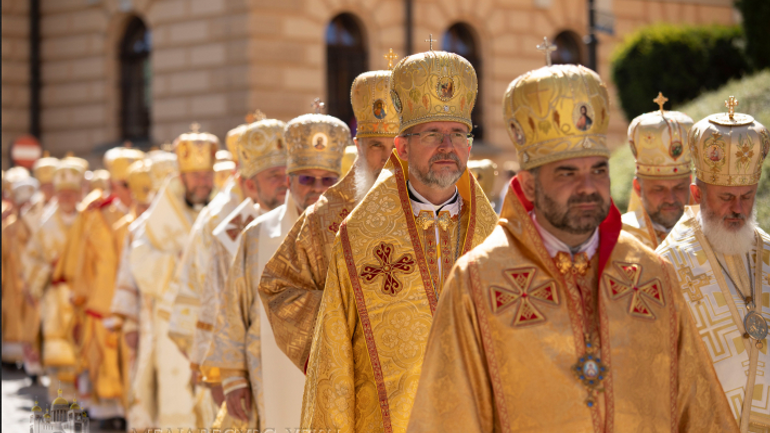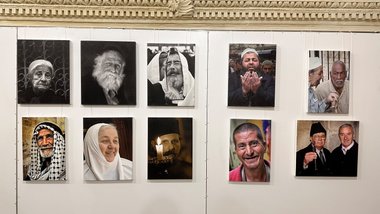War, refugees dominate bishops' talk at Ukrainian Catholic synod on synodality meeting

But with more than 12 million Ukrainians fleeing their homes in the last six months, the UGCC is finding many of its members scattered. Both those who have left and those who remain are suffering.
So when the Ukrainian Greek Catholic bishops recently held their first in-person meeting since 2019, their planned conversation about synodality was largely displaced by discussions about the ongoing war in Ukraine, and its consequences for the Church.
The July 7-15 synod gathering for Ukrainian Catholic bishops was part of the Church’s synod on synodality. But several bishops suggested that the UGCC is already a strongly synodal body, and the focus of conversation turned to the plight of refugees, the treatment of trauma, and the pastoral care of soldiers and victims.
“Our Church provides a great deal of assistance to the victims, but we also see that while at the beginning there was a great deal of humanitarian aid, now there is less, and it all requires good coordination so that the aid gets to those who need it most,” said Bishop Vasyl Tuchapets, exarch of Kharkiv in eastern Ukraine, who heads social ministry efforts for the Ukrainian Church.
“We see that children are suffering the most today. Some families can't move to safe places. The situation of constant stress is seriously affecting their health in general. Because of permanent stress and fear, some stop talking; they sleep very badly at night. Many children sit in basements all day long.”
The bishop told The Pillar that the Church has made efforts to organize events for children to play games an interact socially.
The synod meeting was attended by 40 Ukrainian Catholic bishops from Ukraine, Central, Northern, and Western Europe, North and South America, and Australia. It was the first time the have been able to meet live in three years, due to the COVID-19 pandemic.
The July meeting of bishops had been scheduled to take place in Ukraine. But because of the ongoing war, it was moved to Przemyśl in Poland, near the Ukrainian border, one of the oldest episcopal sees of the Ukrainian Greek Catholic Church.
Poland has also received the greatest number of Ukrainian refugees since Russia’s February attack on Ukraine. The bishops were able to visit various parishes and communities that helped Ukrainians forced to flee their homes.

Tuchapets told The Pillar that he visited a psychiatric rehab clinic recently, which was overcrowded by the military, who are having difficulty coping with their experience and the loss of their comrades. He said there is a great need to build more rehabilitation centers for both civilians and members of the military.
Yurii Pidlisnyi, a chairman of the UGCC's Commission on Family and Laity, said he believes the Catholic Church's social teaching has a vital role to play in rebuilding Ukraine after the war ends, just as it did in Western Europe after World War II.
“This war has stirred up so many Christians in Europe and the world,” he said. “I have spoken to many representatives of Justice and Peace commissions in various countries, and they are asking themselves what 'justice' means and what 'peace' means today.”
“They see the need to rethink these important categories because every era, every war, and every conflict makes its corrections, especially when one of the parties, in the spirit of post-modernity, in the spirit of post-truth, completely disregards both peace and justice.”
Discussing pastoral care of refugees, Bishop Stepan Sus, curial bishop of the Major Archbishopric of the Kyiv Halych, told The Pillar that there is a significant difference between countries where the Church is already present, and those where it is not.
“In some countries, we already have an established structure, which is often a great help for people, because they come to the church first and seek support and help there. But there are [other] countries where we do not have parishes, and now people ask to send a priest there.”
Sus heads the UGCC’s pastoral and migration department, which aims to help Ukrainian Catholics in the regions without UGCC parishes His office works to identify the needs of people, and to work with other religious and government entities to help meet them.
"When we speak of the vocation of our Church, it is to be with our people where they are and in the different circumstances of their lives. Right now, we are first of all analyzing where our faithful are right now, where they have moved, and how long they will be there. And we understand that today, it's difficult to get reliable data because we don't know how long people will stay in the places where they find themselves,” he said.
“People are constantly moving now because they are looking for better living conditions, making our work more difficult,” he continued. “For example, 800,000 people crossed the border into Hungary, but how many of them are in that country now and how many have moved on is hard to say.”
Among the Ukrainian refugees, the bishop told The Pillar, many people come from the southern and eastern regions of Ukraine, which during the Soviet Union had experienced the most vigorous atheistic propaganda. Even today, people from today often remain largely secularized in comparison to western Ukraine. Now, forced to leave their homeland, some are encountering the faith in a new way.
“For many people, these tragic events were also a turning point in their understanding of Church and spiritual life,” he said. “Some didn’t even know the Lord's Prayer. I often tell our priests that they may have once dreamed of going to eastern Ukraine on missions. Now they have the opportunity to have that experience in Spain, Portugal, or the Baltic states.”
The bishops made several governance decisions at the synod, including approving a new translation of the Divine Liturgy of Saint John Chrysostom into the Ukrainian language, and the updated Strategy for the Development of Social Ministry in the UGCC.
In their discussion on synoldity, the bishops noted unique structures in the Eastern Catholic Churches — which they say already lend themselves to a more synodal way of functioning.
“At the call of the pope, we entered into the synodal process of the whole Catholic Church with two objectives: to deepen our understanding of the synodal nature of the Eastern Churches and different levels of synodality that exist in our Church,...[and] Secondly, as an Eastern Church, we were reflecting on what we could share with the whole Universal Church,” auxiliary bishop Teodor Martyniuk of Ternopil told The Pillar.
The listening and inclusiveness called for by Pope Francis already exist in the Eastern Catholic Churches in the form of parish councils, diocesan assemblies (sobors) in which the laity and clergy participate, as well as a Patriarchal assembly (sobor) held every five years in which clergy and laity from all UGCC dioceses from around the world are represented, he said.
Martyniuk - who was elected as a UGCC delegate to the next Ordinary Synod of Bishops, to be held in Rome in October 2023 - said he is convinced that the Eastern Churches do not need to create new forms of synodality, but instead improve their existing ones.
He also noted that the UGCC is not a territorial reality, like episcopal conferences corresponding to certain countries. That influences the synodal process, he said.
“Synthesis reports to the Vatican’s General Secretariat of the Synod of Bishops prepared by Roman Catholic bishops' conferences are rooted in the context of their countries,” he said. “Our synthesis could not be limited to Ukraine; we had to remember about all our people living in different countries.”
Pidlisnyi noted that there have been different proposals made about meaning of synodality.
“For some, it is an activation of the laity,” he said. “But another understanding is that the laity should participate in any decision-making in the Church. Some circles, for example, suggest that even questions of a moral nature should be decided by some consensus, by a balance of opinion. But to do so would be equivalent to eliminating the Church because even in two neighboring dioceses or parishes, there can be a completely different ‘consensus.’”
In the UGCC, Pidlisnyi continued, laity have long played a significant role, “and the Church owes a great deal to the laity who kept it alive during the period of Soviet persecution in the catacombs. Laymen hid underground priests and organized secret services in their homes.”
The laity, Pidlisnyi said, “already have practical ways of conveying their opinion to the synod of bishops,” he said. “Now it is important that the laity go beyond the church walls and, with their knowledge of the social teaching of the Church, be able to influence what is done locally or nationally, to influence the lawmaking process.”
“UGCC became a prominent member of civil society quite a long time ago,” he said. “It would be ideal to strengthen these opportunities for the wider evangelization of society, that is, to shape the agenda of social processes. And this is a task for all the laity, clergy, and bishops – this is our ‘synodal way’ - so that it does not happen like in the 19th century, when the Church was 50 years late with its social teaching and observed how Marx and Engels shaped the political agenda in Europe.”










